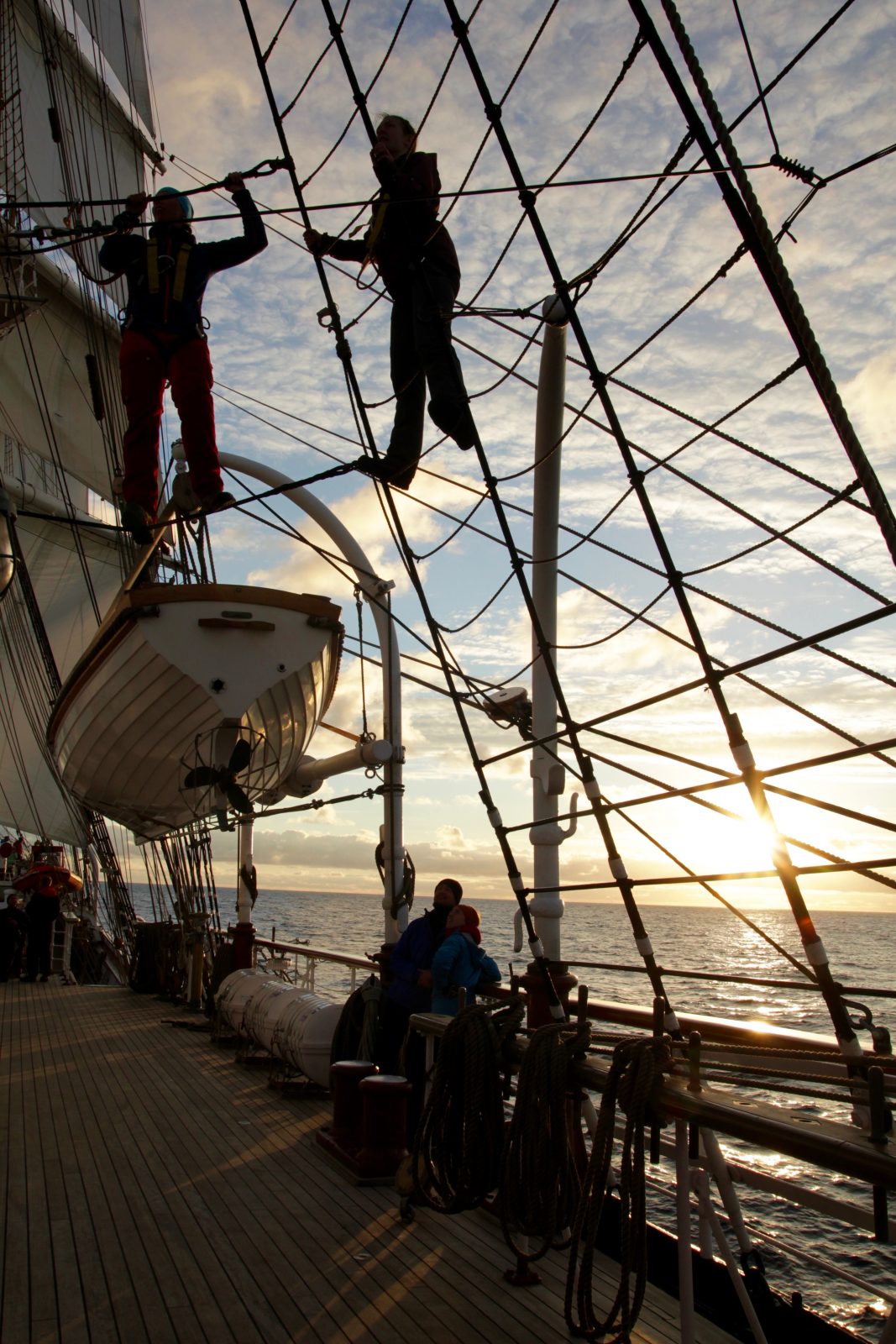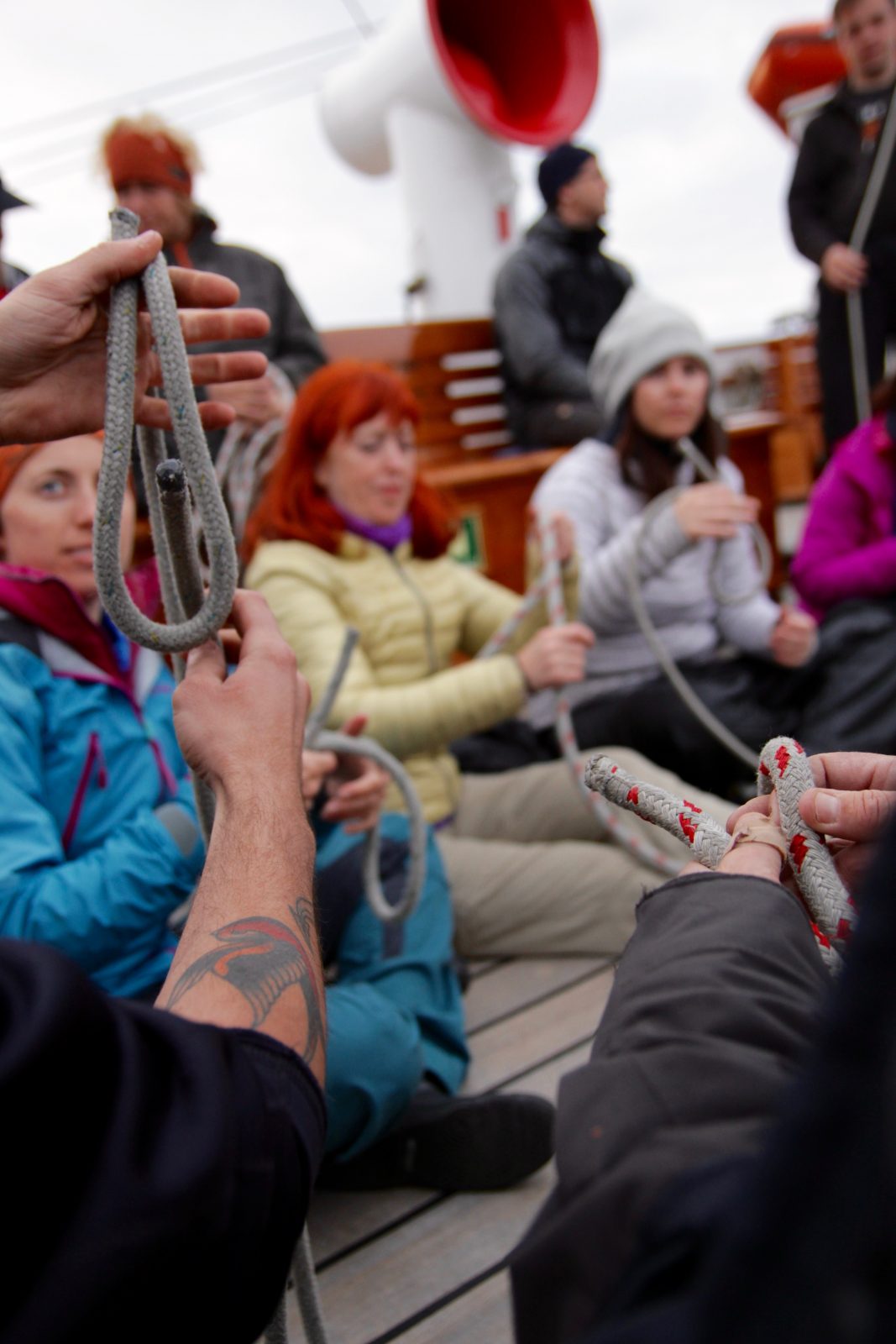Sailing voyages
Team spirit, sailing and seamanship!
As a voyage crew member, you become an active part of the team on board. Here, team spirit, seamanship, and nature experiences go hand in hand. Join in hoisting the sails, standing lookout, mending the helm, learning navigation and climbing the rigging - if you dare! We can't promise you a relaxing luxury vacation, but we guarantee this is a journey you'll never forget!
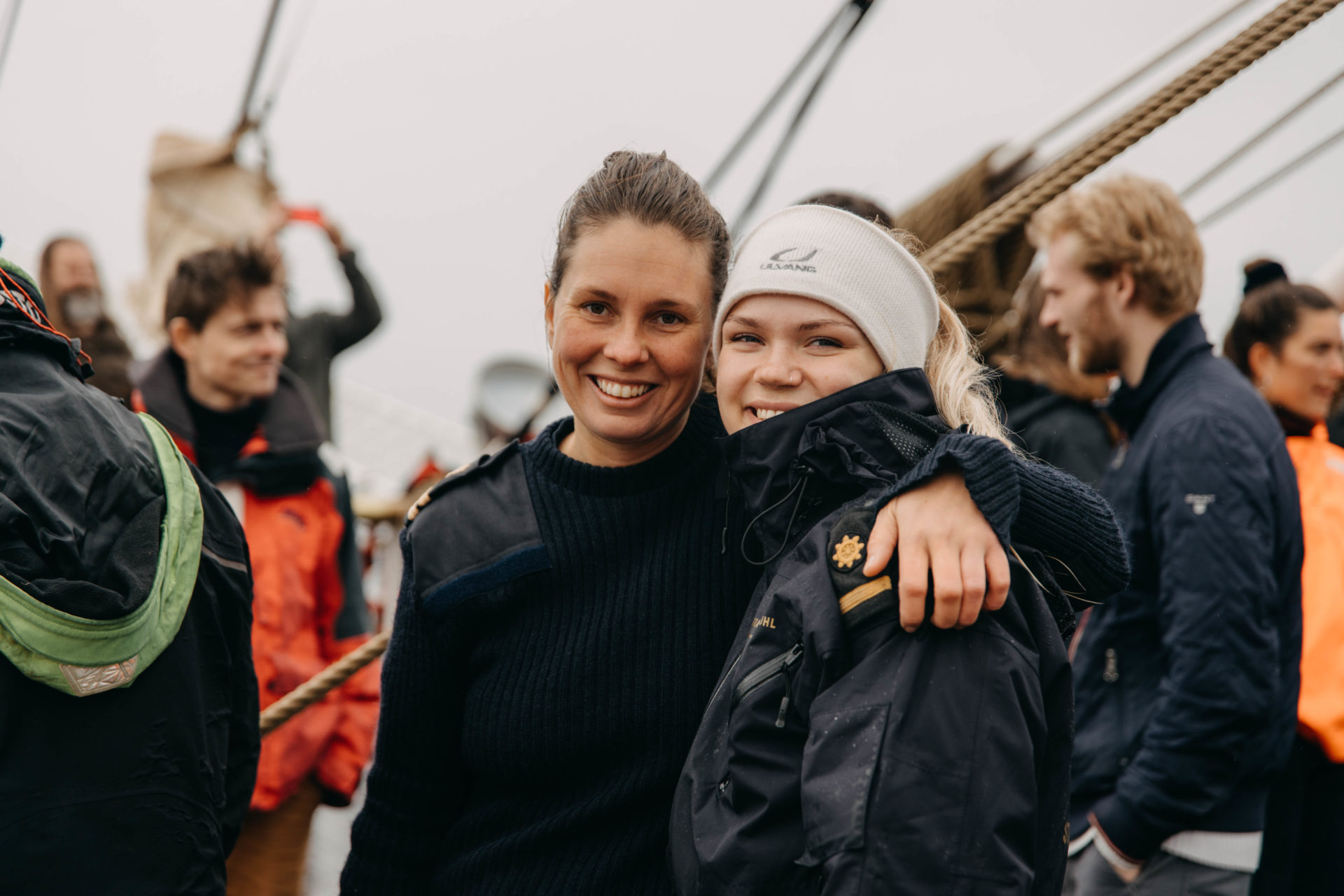
Authentic experiences and a mobile-free zone! In short, a sailing voyage is, above all, incredibly fun – and an exciting challenge for many! It’s a mix of hard work and relaxation. It’s about team spirit and friendship, stormy weather and sunshine. It’s awe-inspiring nature experiences and small, precious moments with good shipmates. On board Statsraad Lehmkuhl, we live closely together in a wonderful, mobile-free “bubble” out at sea! A sailing voyage is a beautiful thing to share with someone you care about. Or, you can muster on alone- on Lehmkuhl, it is easy to make new friends!
Photo: Hanna Thevik
NO PRIOR EXPERIENCE NEEDED
Many people think that you need sailing experience to embark on a voyage with Statsraad Lehmkuhl, but fortunately, that’s not the case! We are a training vessel and have taught people how to sail for over 100 years.
At first, there may be a lot to learn – but don’t worry! The ship’s friendly and professional crew will provide you with all the training you need, and you’ll master the tasks in no time! Feel free to ask any of the crew if you have questions!
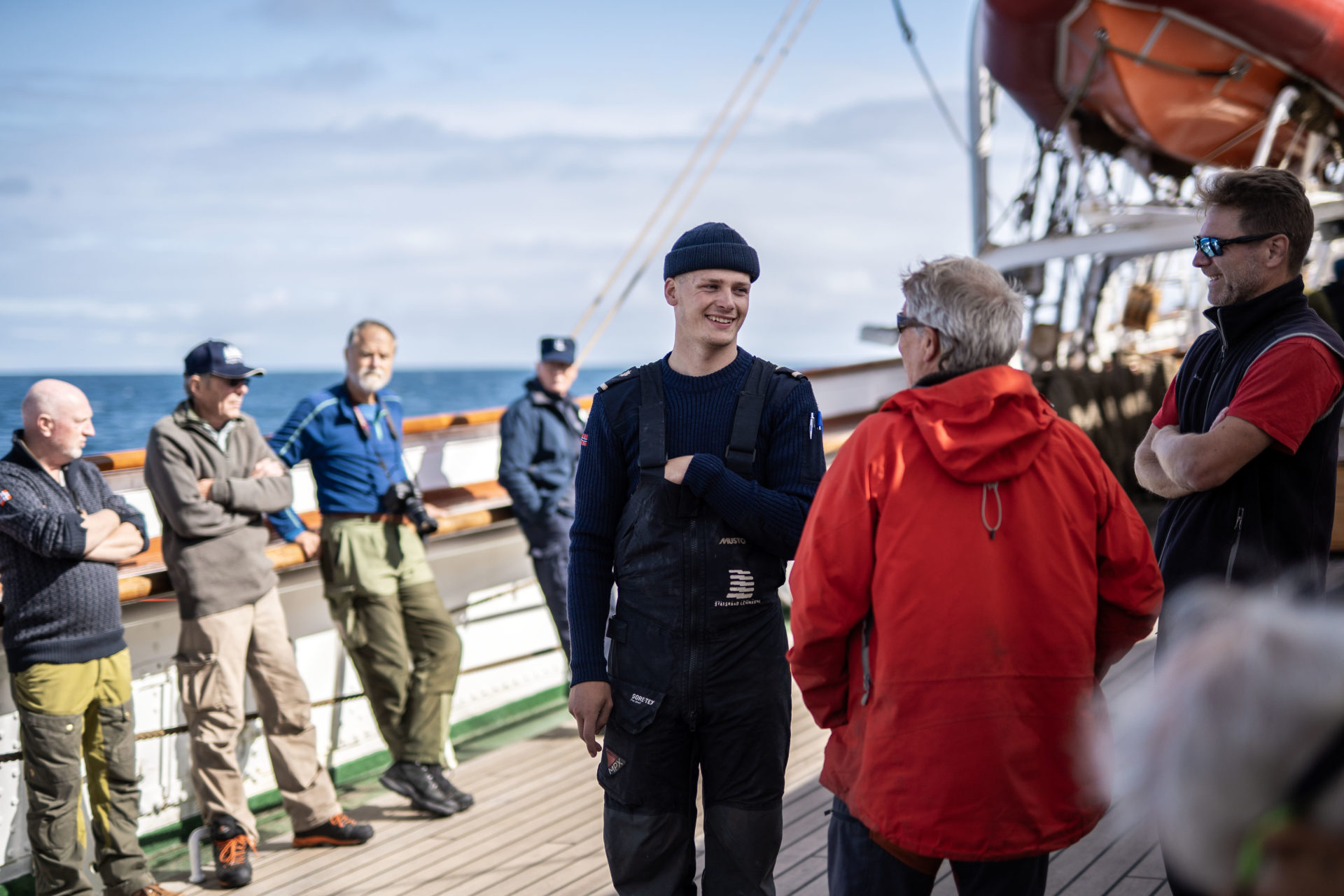 The ship’s professional crew, represented here by able seaman Haavard Botnen, provides you with safe and thorough training, allowing you to participate in the many activities on board. Photo: Malin Kvamme.
The ship’s professional crew, represented here by able seaman Haavard Botnen, provides you with safe and thorough training, allowing you to participate in the many activities on board. Photo: Malin Kvamme.
SLEEP IN A HAMMOCK
There are no cabins available for the voyage crew on Statsraad Lehmkuhl. Here, you sleep side by side in hammocks on the banjer, just as sailors have done for centuries. The banjers are the sleeping and living quarters below deck. There are two banjers: fore and aft, both equipped with air conditioning and heating.
Some may be a bit skeptical about swapping their bed for a hammock, but the hammocks are exactly what make the sailing voyage a unique and authentic experience! Many quickly discover that it can actually be an excellent way to sleep, especially in rough seas. The hammock works like a gyroscope, absorbing much of the ship’s motion.

The hammocks hang close together when the ship is full, so it’s important to be considerate of one another. Photo: André Marton Pedersen.
Sleeping pads are provided in the hammocks, but you’ll need to bring your own sleeping bag and pillow. We recommend earplugs and possibly a sleep mask. Expect some noise, especially when the banjer is full.
The ship’s professional crew has cabins located elsewhere on the vessel.
The watch teams sleep side by side in hammocks, just as sailors have done for centuries.
“DIGITAL DETOX”
As the ship approaches open sea, internet and phone coverage disappear. The voyage crew does not have access to the ship’s wifi. In other words, you can put your phone away and fully immerse yourself in the moment, far away from the hustle and bustle of everyday life!
The ship’s professional crew is in daily contact with shore and can relay important messages. In special situations, the ship’s satellite phone can be used.
 It’s a wonderful feeling to disconnect for a few days—with a clear conscience! Photo: Hanna Thevik
It’s a wonderful feeling to disconnect for a few days—with a clear conscience! Photo: Hanna Thevik
SEA WATCHES
The sea watch system has a long tradition at sea and is the backbone of the operation of the ship.
Shortly after boarding, everyone is divided into three watch teams: red, white, and blue. This will be your core group for the voyage. Together, you will take part in four-hour sea watches twice a day. Altogether, you will be on watch for 8 hours per day.
The three watch teams are led by the ship’s professional crew, who are always present on deck to ensure safety. While on watch, you receive training and participate in sail maneuvers. Other activities include learning knots and splices, mending the helm, keeping lookout and serving as fire watch.
The sea watches are arranged as follows:
– Red watch: 12 PM – 4 PM / 12 AM – 4 AM
– White watch: 4 AM – 8 AM / 4 PM – 8 PM
– Blue watch: 8 AM – 12 PM / 8 PM – 12 AM
About half an hour before each watch change, the oncoming watch is called to muster (woken up).

On board a sailing ship, everyone literally has to pull in the same direction! Photo: Malin Kvamme
MEALS
All meals are included; breakfast, lunch, and dinner, as well as a snack for the three o’clock coffee and a light bread meal for the night watch. We can accommodate dietary needs as far as practically possible (vegetarian, pescatarian, gluten-free). Please enter any special dietary requirements in the comment field on your ticket after booking. Unfortunately, we are not able to provide a vegan diet.
If you have severe food allergies or other questions about meals on board, please contact us: lehmkuhl@lehmkuhl.no / +47 55 30 17 00 (Mon–Fri, 10–14 CET).
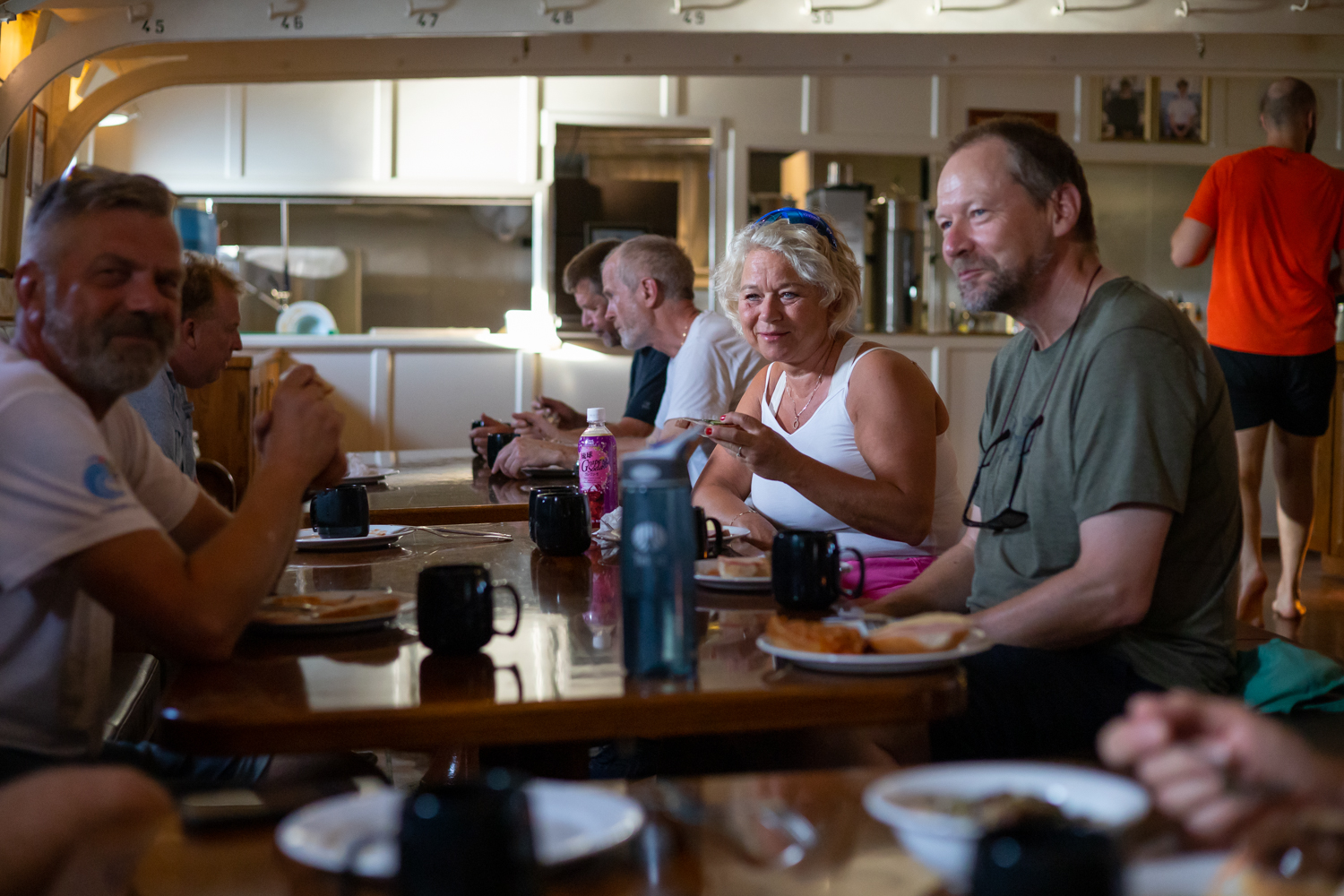 Meals are served buffet-style and enjoyed together on the fore banjer. Photo: André Marton Pedersen.
Meals are served buffet-style and enjoyed together on the fore banjer. Photo: André Marton Pedersen.
Meal times
- 7:20 AM – 8:30 AM Breakfast
- 11:20 AM – 12:30 PM Lunch
- 5:30 PM – 6:30 PM Dinner
In addition, there are two scheduled 15 minute breaks each day: one at 10 AM and one at 3 PM. 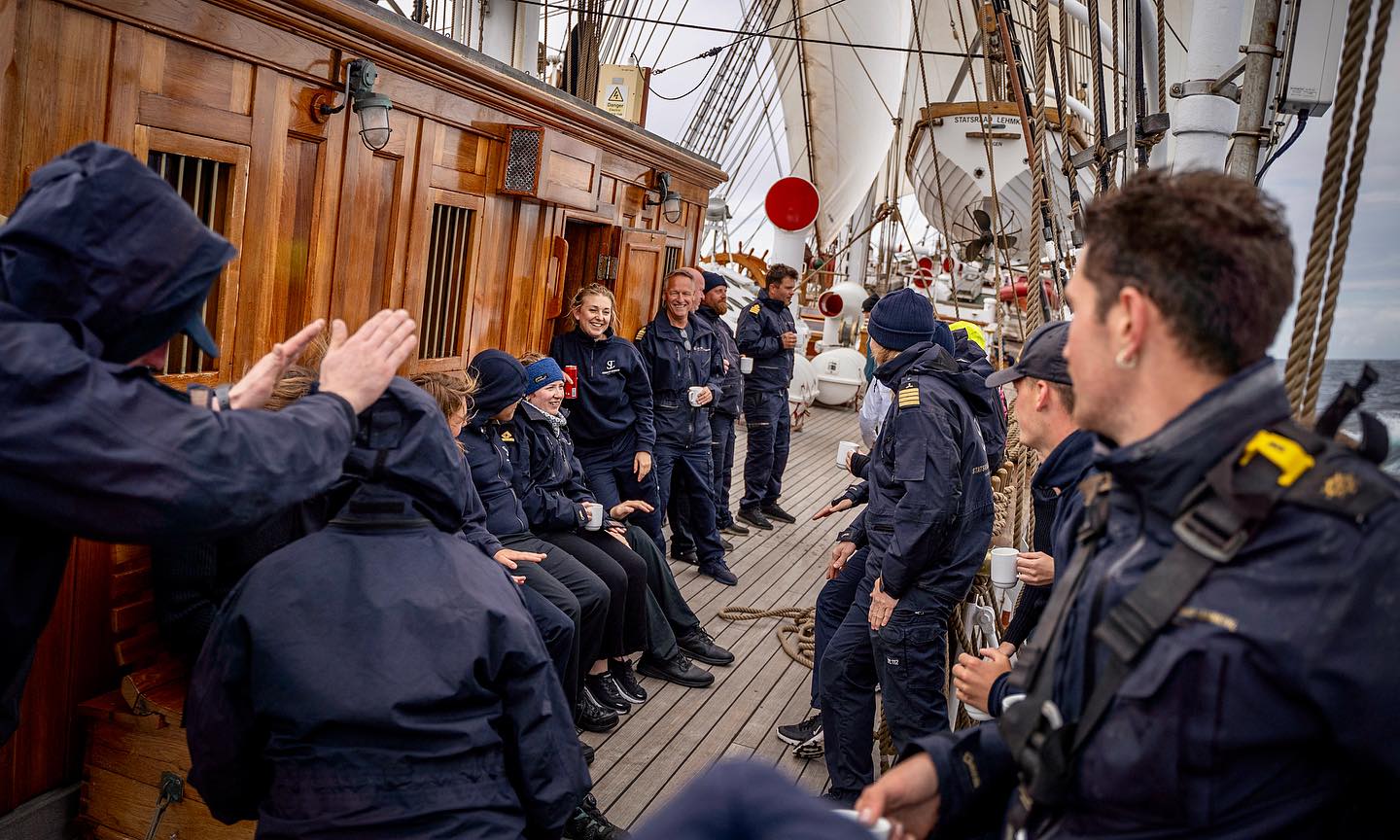
The ship’s crew also appreciates the 10 AM and 3 PM coffee breaks, where everyone gathers for a pleasant chat. Photo: Malin Kvamme.
AGE LIMITS
One Ocean Expedition voyages: Participants must be at least 15 years old and accompanied by a guardian. To travel alone, you must be 18 years old by the start of the voyage.
Tall Ships Races: Minimum age 15 years. Can travel alone from age 15.
Other voyages: Minimum age 12 years. Must travel with a parent/guardian. Can travel alone from age 15.
See the specific voyages for more information.
Please note that the ship’s crew unfortunately does not have the capacity to provide individual supervision for those who require special attention.
If you are over 70 years old, you must provide a signed medical certificate confirming that you are in good health and fit to participate in the voyage. The medical certificate will be sent via email upon request.
Three generations on their way to Shetland with Statsraad Lehmkuhl. Photo: Ronald Toppe.
FIRST MEETING WITH THE SHIP
To ensure a smooth start with the initial muster and training, it’s great if everyone arrives in good time.

Boarding has begun. The ship’s quartemaster oversees the check-in process and collects all passports, which will be returned to you before arriving at the next port. Photo: Malin Kvamme.
At check-in, you will be assigned a hammock number that matches the number on your locker. You will also be given a muster position based on your watch team and hammock number.
The first group activity is muster (assembly) on the main deck. Here, the crew will go over important safety information and demonstrate the use of the rescue equipment.
Whenever your muster number or name is called, respond with a loud and clear “HOY!” It might feel unfamiliar at first, but you’ll get the hang of it in no time!
SAFETY
Safety is always the top priority on board. Be sure to pay close attention when the crew explains the equipment and rules. Understanding the safety regulations won’t limit your experience—in fact, it gives you the confidence to fully enjoy and participate in all the activities on Norway’s largest sailing ship.
ENTERING THE RIGGING
Everyone who enters the rigging is secured with a safety line.
Entering the rigging is a voluntary activity. If you’re unsure whether you want to “go aloft” or not, we recommend giving it a try! The view is spectacular, and the sense of accomplishment will stay with you for a lifetime! Remember, it’s perfectly fine to change your mind halfway up!
Beforehand, the watch leader will give you a thorough safety briefing, and on your first ascent, a crew member will accompany you to ensure everything goes smoothly. As you gain confidence, you can enter the rigging on your own, but never without prior approval from the watch leader.
During most voyages, there will be several opportunities to enter the rigging. On shorter voyages, lasting 2-3 days, there will be fewer chances to go up.

For many in the voyage crew, entering the rigging becomes a highlight of the voyage, but it’s completely voluntary whether you want to “go aloft” or not. To work with the sails, people are needed both in the rigging and down on deck. On a sailing ship, everyone is equally important! Photo: Malin Kvamme.
PHYSICAL REQUIREMENTS FOR RIGGING ACCESS
– Full rig access: Either 1 standard pull-up or 5 Bravo pull-ups, followed by a 10-second dead hang. See video of the Bravo pull-up (YouTube).
– Limited access: Hanging freely by the arms for 10 seconds allows access to the lower shrouds, lower yards (up to the first platform, but not above it), and the bowsprit.
If you do not meet the requirement of dead hang for 10 seconds, you are unfortunately not permitted to enter the rig at all, including the bowsprit. These physical requirements are directly linked to safety, and we regret that they may limit some participants’ ability to move about in the rig.
PACKING LIST AND LOCKER SPACE
What you should pack naturally varies depending on the season. In general, it’s often a bit colder at sea than on land.
* Sleeping bag. The banjers are heated, but in autumn, it’s wise not to choose the thinnest bag.
You may also want to bring a pillow, earplugs, and a sleep mask.
* Wind- and waterproof clothing for cold watches on deck.
* Wool or thermal underwear.
* Functional clothing suitable for rig climbing, rope pulling, and handling tar.
* Sturdy rain gear, including both jacket and pants.
*. Water-resistant boots/shoes and sneakers/hiking shoes.
* Gloves for cold helm watches.
* Towels, toiletries, and sunscreen.
* Small flashlight.
* Other everyday clothes appropriate for the conditions.
* Slippers or similar for the shower.
*. Water bottle
In the spirit of sustainability, we encourage everyone to use what they have rather than buying a lot of new gear!
There is limited space for personal belongings on board. Therefore, pack in a soft, collapsible bag or duffel that can easily be stored away. On the banjer, you will have access to a lockable locker (35 x 70 x 80 cm), as well as a drawer in a sea chest. The drawers come in two different sizes: 66 x 34 x 56 cm and 32 x 53 x 43 cm.
VOYAGE LETTER
Well in advance of the voyage, we will send you a voyage letter with information on the packing list, dock location, and more.
DEPARTURE AND ARRIVAL TIMES
We usually stick to the schedule, but departure and arrival times may occasionally differ from those on your ticket. As we travel on a sailing ship, we must adapt to the wind and weather conditions. If the wind isn’t in our favor, we may need to use the engine to reach the arrival port on time. Nevertheless, we recommend allowing at least a three-hour margin for any onward travel.
VWELCOME ON BOARD FOR A UNIQUE EXPERIENCE THAT CREATES MEMORIES FOR A LIFETIME!
 Photo: Torjus Hoven
Photo: Torjus Hoven
Phone: 55 30 17 00 (10:00 AM – 2:00 PM)
Email: lehmkuhl@lehmkuhl.no
The office at Bradbenken is open from 9:00 AM to 4:00 PM.
Our travel terms can be found here.
Photo below: André Marton Pedersen
